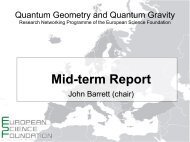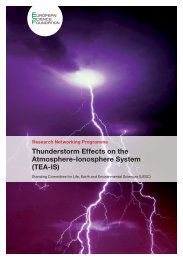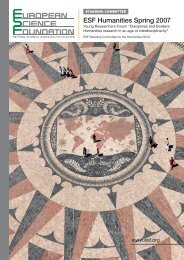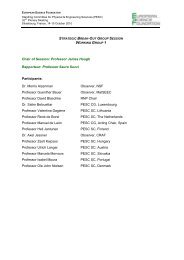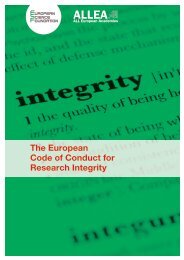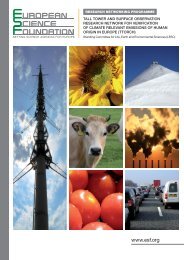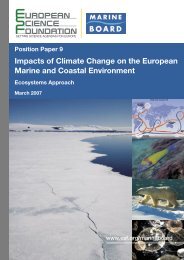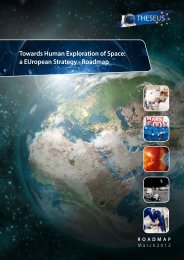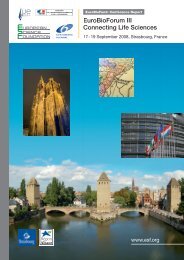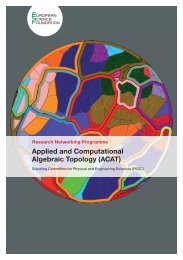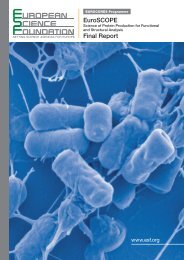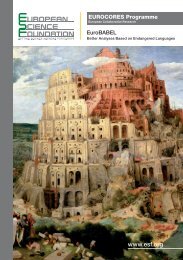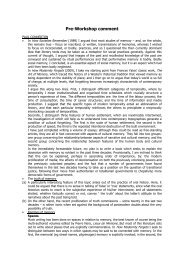Synthesis Report - European Science Foundation
Synthesis Report - European Science Foundation
Synthesis Report - European Science Foundation
Create successful ePaper yourself
Turn your PDF publications into a flip-book with our unique Google optimized e-Paper software.
References54Responses to Environmental and Societal Challenges for our Unstable Earth (RESCUE)CoFIR et al. (2005). Committee on FacilitatingInterdisciplinary Research, Committee on <strong>Science</strong>,Engineering, and Public Policy, National Academy of<strong>Science</strong>s, National Academy of Engineering, and Instituteof Medicine of the National Academies. Facilitatinginterdisciplinary research. Washington, DC: NationalAcademies Press.Corcoran, P.B. and Wals, A.E.J. (eds) (2004). HigherEducation and the Challenge of Sustainability: Problematics,Problems, and Practice. Dordrecht: Kluwer AcademicPublishers.Crumley, C. (2007). Historical ecology: Integrated thinkingat multiple temporal and spatial scales. In: The World Systemand The Earth System: Global Socio-Environmental Changeand Sustainability Since the Neolithic, A. Hornborg and C.Crumley (eds), pp. 15-28. Walnut Creek, CA: Left CoastPress.Crutzen, P.J. (2002). The Anthropocene: Geology ofmankind. Nature 415, 23.Crutzen, P.J. and Stoermer, E.F (2000). The Anthropocene.Glob. Change Newsl. 41, 17-18.de Sherbinin, A. (2009). The Biophysical and GeographicalCorrelates of Child Malnutrition in Africa. Population,Space and Place 15, dx.doi.org/10.1002/psp.599.de Sherbinin, A. (2010). Summary of the Population–Environment Research Network Cyberseminar: Whatare the Remote Sensing Data Needs of the Population–Environment Research Community?www.populationenvironmentresearch.org/papers/RS_cyberseminar_summary.pdfde Sherbinin, A. et al. (2002). Social <strong>Science</strong> Applicationsof Remote Sensing. A CIESIN Thematic Guide. Palisades,NY: Center for International Earth <strong>Science</strong> InformationNetwork of Columbia University.DEA (2008) Thinking across disciplines – interdisciplinarityin research and education. Danish Business ResearchAcademy (DEA). fuhu.dk/filer/FBE/Publikationer/thinking_across.pdfDilley, M. et al. (2005). Natural Disaster Hotspots: A GlobalRisk Analysis. Analysis produced for the World Bank. sedac.ciesin.columbia.edu/hazards/hotspots/synthesisreport.pdfDozier, J. and Gail, W.B. (2009). The Emerging <strong>Science</strong>of Environmental Applications. In: The Fourth Paradigm:Data-Intensive Scientific Discovery, T. Hey, S. Tansley and K.Tolle (eds). Redlands, WA: Microsoft Research.Dreborg, K.H. (1996). Essence of backcasting. Futures 28(9),813-828.EEAC (2008). Sustaining Europe for a long way ahead,Making long-term sustainable development policies work.Sept. 2008. 8p. www.eeac-net.org/download/EEAC_WG_SD_statement_2008_final.pdfEEAC (2011). Statement and Background Papers on: UNCSDRio20plus - The “Green Economy” Agenda in the context ofSD Institutional Framework for SD at national level. Sept.2011. 44p. www.eeac.eu/images/doucments/eeac-statementbackgr2011_rio_final_144dpi.pdfEsbjörn-Hargens, S., Reams, J. and Gunnlaugson, L. (2010).The Emergence and Characteristics of Integral Education.In: Integral Education: New Directions for Higher Learning,S. Esbjörn-Hargens, J. Reams and L. Gunnlaugson (eds),1-16. Albany: SUNY Press.ESF (2002). ESF Forward Look on Global Change Research.<strong>European</strong> <strong>Science</strong> <strong>Foundation</strong> Policy Briefing 2, September2002. www.esf.org/publications/forward-looks.htmlESF (2010). The Future of Knowledge: Mapping Interfaces.<strong>European</strong> <strong>Science</strong> <strong>Foundation</strong>, Strasbourg.Ezrahi, Y. (1990). The Descent of Icarus: <strong>Science</strong> and theTransformation of Contemporary Democracy. Cambridge,MA: Harvard University Press.Faghihimani, M. (2011). Higher Education andCommitment to Environmental Sustainability(Dissertation). To be presented in September 2011,University of Oslo.Fazey, I. (2010). Resilience and Higher Order Thinking.Ecology and Society 15(3), 9.Fazey, I. et al. (2007). Adaptive capacity and learning tolearn as leverage for social-ecological resilience. Frontiers inEcology and Environment 5(7), 375-380.Feller, I. (2006). Multiple actors, multiple settings, multiplecriteria: issues in assessing interdisciplinary research.Research Evaluation 15(1), 5-15.Frame, B. (2008). ‘Wicked’, ‘messy’ and ‘clumsy’: Long-termFrameworks for Sustainability. Environment and PlanningC: Government and Policy 26(6), 1113-1128.Frame, B. and O’Connor, M. (2011). Integrating valuationand deliberation: the purposes of sustainability assessment.Environmental <strong>Science</strong> & Policy 14, 1-10Fraser, E.D.G., Mabee, W. and Slaymaker, O. (2003). Mutualvulnerability, mutual dependence: The reflexive relationbetween human society and the environment. GlobalEnvironmental Change 13, 137–144.Freire, P. (1972). Pedagogy of the Oppressed.Harmondsworth: Penguin.



